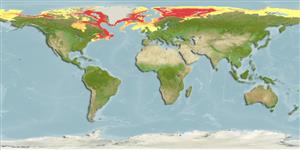Environment: milieu / climate zone / depth range / distribution range
Ecologia
marinhas demersal; intervalo de profundidade 6 - 1750 m (Ref. 117245). Polar; 83°N - 41°N, 180°W - 180°E
Circumarctic (Ref. 11954). Northeast Atlantic: northeast Greenland, Jan Mayen Island, northern coasts of Iceland, Faroes-Shetland slope, northern part of Barents Sea, White Sea and around Spitsbergen. Northwest Atlantic: Arctic Canada to Labrador and Gulf of St. Lawrence; possibly to Cape Cod in Massachusetts, USA (Ref. 7251). Arctic Ocean: Kara Sea, western part of Laptev Sea, Beaufort Sea and Arctic Canada. Subspecies(?) Lycodes pallidus marisalbi in White Sea only (Ref. 4695).
Tamanho / Peso / Idade
Maturity: Lm ? range ? - ? cm
Max length : 26.0 cm TL macho/indeterminado; (Ref. 4695); common length : 18.0 cm TL macho/indeterminado; (Ref. 4695)
Descrição suscinta
Chaves de identificação | Morfologia | Morfometria
Vértebras: 90 - 93. Pelvic fins small (Ref. 4695). Young with pale, yellowish-brown body, with 6-8 light and narrow cross bands which are more distinct on the dorsal fin; larger individuals lose the bands, becoming more or less uniformly colored (Ref. 4695).
Found on muddy bottoms (Ref. 4695). Benthic (Ref. 58426). Feeds mostly on endobenthic prey such as small bivalves, polychaetes and small crustaceans in addition to detritus. It seems to get the bulk of its food by burrowing in the sediment (Ref. 13532). Ripe females recorded in September in the Kara Sea (Ref. 4695). Minimum depth from Ref. 58018.
Ciclo de vida ou comportamento de acasalamento
Maturities | Reprodução | Spawnings | Egg(s) | Fecundities | Larvas
Anderson, M.E., 1994. Systematics and osteology of the Zoarcidae (Teleostei: Perciformes). Ichthyol. Bull. J.L.B. Smith Inst. Ichthyol. 60:120 p. (Ref. 11954)
Status na Lista Vermelha da UICN (Ref. 130435)
Ameaça para os humanos
Harmless
Uso pelos humanos
Ferramentas
Relatórios especiais
Baixar XML
Fontes da internet
Estimates based on models
Preferred temperature (Ref.
123201): -0.9 - 4.9, mean 0.8 °C (based on 2262 cells).
Índice de diversidade filogenética (Ref.
82804): PD
50 = 0.5000 [Uniqueness, from 0.5 = low to 2.0 = high].
Bayesian length-weight: a=0.00263 (0.00137 - 0.00504), b=3.22 (3.06 - 3.38), in cm total length, based on LWR estimates for this Genus-body shape (Ref.
93245).
Nível Trófico (Ref.
69278): 3.1 ±0.36 se; based on food items.
Resiliência (Ref.
120179): médio(a), tempo mínimo de duplicação da população 1,4 - 4,4 anos (Preliminary K or Fecundity.).
Fishing Vulnerability (Ref.
59153): Low vulnerability (16 of 100).
